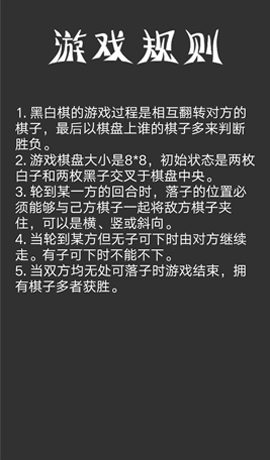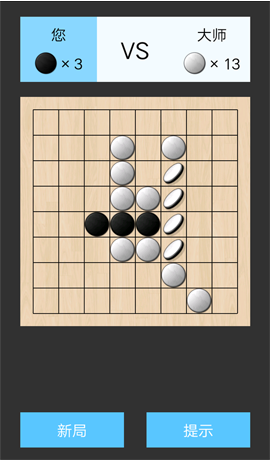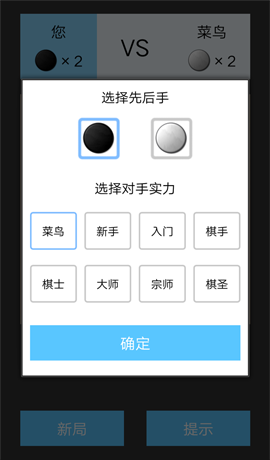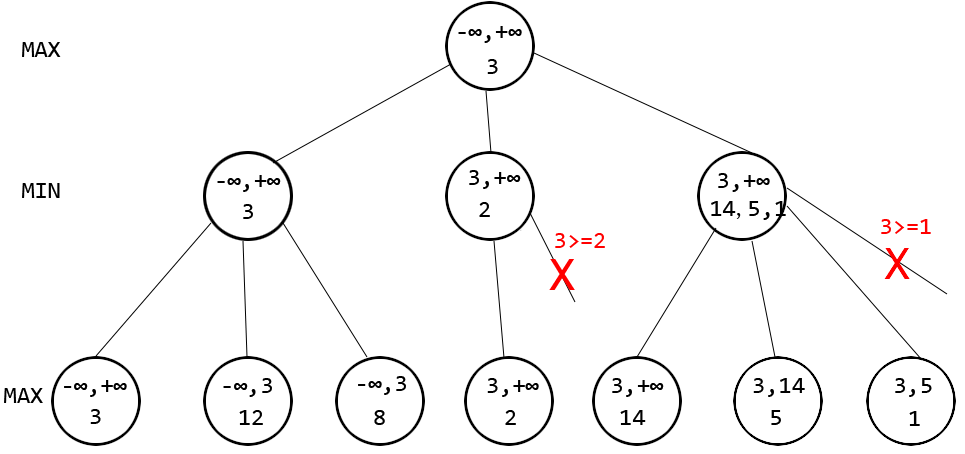
- APK程序获取system权限的方法
- [Java4Android]21_对象的转型
- [Android开发从零开始].28.使用DOM和pull解析XML
- Android实现的可以调整透明度的图片查看器实例
- Android调用堆栈跟踪实例分析
- Android 使用 ViewPager循环广告位的实现
- 浅析Android手机卫士自定义控件的属性
- Android三种菜单实例分析
- WindowManagerService服务是如何以堆栈的形式来组织窗口
- Android访问php取回json数据实例
- Android搜索框组件SearchView的基本使用方法
- Android序列化XML数据
- Android实现仿淘宝购物车增加和减少商品数量功能demo示例
- 解析:android 如何从JPEG生成BufferedImage
- 基于Android 监听ContentProvider 中数据变化的相关介绍
- [Android开发从零开始].3.第一个Android程序
- Android中创建一个透明的进度对话框实例
- Android图片加载缓存框架Glide
- 安装时加入外部数据库示例(android外部数据库)
- Android TextView跑马灯效果实现方法
- Android ListView数据绑定显示的三种解决方法
- 解决video标签在安卓webview下无法自动播放问题
- Android仿UC底部菜单栏实现原理与代码
- Android-屏幕适配需要注意的地方总结
- adnroid已安装应用中检测某应用是否安装的代码实例
- Android图片占用内存全面分析
- android使用gesturedetector手势识别示例分享
- android应用实现开机自动启动方法
- Ubuntu中为Android简单介绍硬件抽象层(HAL)
- android 添加随意拖动的桌面悬浮窗口
Android游戏开发之黑白棋
黑白棋介绍
黑白棋,又叫苹果棋,最早流行于西方国家。游戏通过相互翻转对方的棋子,最后以棋盘上谁的棋子多来判断胜负。黑白棋非常易于上手,但精通则需要考虑许多因素,比如角边这样的特殊位置、稳定度、行动力等。本游戏取名为黑白棋大师,提供了8种难度等级的选择,从菜鸟、新手、入门、棋手到棋士、大师、宗师、棋圣,助你不断提升棋力。
黑白棋游戏规则
游戏规则见黑白棋大师中的截图。

黑白棋大师游戏截图
游戏启动界面。

游戏过程中的一个截图。

开新局时的选项,选择先后手以及AI的水平。

几个关键的类
Rule
Rule类实现游戏规则相关的方法,包括
1.判断某一步是否合法
2.获取所有的合法走步
3.走一步并翻转敌方棋子
4.统计两方棋子个数
Algorithm
Algorithm类实现极小极大算法,包括
1.局面评估函数,对当前局面打分,越高对max越有利,越低对min越有利
2.min()方法
3.max()方法
4.获得一个好的走步
ReversiView
ReversiView继承自SurfaceView,实现棋盘的界面,在该类定义棋盘界面的绘制、更新等操作。
RenderThread
RenderThread继承自Thread,是控制ReversiView以一定fps更新、重绘界面的线程。
具体实现
棋盘表示
byte[][]二维数组存储棋盘,-1表示有黑子,1表示有白子,0表示棋格为空
游戏规则类Rule的实现
提供几个关于游戏规则的静态方法。
判断某一个位置是否位于棋盘内
public static boolean isLegal(int row, int col) {
return row >= 0 && row < 8 && col >= 0 && col < 8;
}
判断某一方在某个位置落子是否合法
即判断该子是否能与己方棋子在某个方向上夹住敌方棋子。
public static boolean isLegalMove(byte[][] chessBoard, Move move, byte chessColor) {
int i, j, dirx, diry, row = move.row, col = move.col;
if (!isLegal(row, col) || chessBoard[row][col] != Constant.NULL)
return false;
for (dirx = -1; dirx < 2; dirx++) {
for (diry = -1; diry < 2; diry++) {
if (dirx == 0 && diry == 0) continue;
int x = col + dirx, y = row + diry;
if (isLegal(y, x) && chessBoard[y][x] == (-chessColor)) {
for (i = row + diry * 2, j = col + dirx * 2; isLegal(i, j); i += diry, j += dirx) {
if (chessBoard[i][j] == (-chessColor)) {
continue;
} else if (chessBoard[i][j] == chessColor) {
return true;
} else {
break;
}
}
}
}
}
return false;
}
某一方走一步子
将各个方向上被翻转的棋子的颜色改变,并返回这些棋子在棋盘的位置,方便显示翻转动画。
public static List<Move> move(byte[][] chessBoard, Move move, byte chessColor) {
int row = move.row;
int col = move.col;
int i, j, temp, m, n, dirx, diry;
List<Move> moves = new ArrayList<Move>();
for (dirx = -1; dirx < 2; dirx++) {
for (diry = -1; diry < 2; diry++) {
if (dirx == 0 && diry == 0)
continue;
temp = 0;
int x = col + dirx, y = row + diry;
if (isLegal(y, x) && chessBoard[y][x] == (-chessColor)) {
temp++;
for (i = row + diry * 2, j = col + dirx * 2; isLegal(i, j); i += diry, j += dirx) {
if (chessBoard[i][j] == (-chessColor)) {
temp++;
continue;
} else if (chessBoard[i][j] == chessColor) {
for (m = row + diry, n = col + dirx; m <= row + temp && m >= row - temp && n <= col + temp
&& n >= col - temp; m += diry, n += dirx) {
chessBoard[m][n] = chessColor;
moves.add(new Move(m, n));
}
break;
} else
break;
}
}
}
}
chessBoard[row][col] = chessColor;
return moves;
}
获取某一方当前全部合法的落子位置
public static List<Move> getLegalMoves(byte[][] chessBoard, byte chessColor) {
List<Move> moves = new ArrayList<Move>();
Move move = null;
for (int row = 0; row < 8; row++) {
for (int col = 0; col < 8; col++) {
move = new Move(row, col);
if (Rule.isLegalMove(chessBoard, move, chessColor)) {
moves.add(move);
}
}
}
return moves;
}
统计玩家和AI的棋子个数
public static Statistic analyse(byte[][] chessBoard, byte playerColor) {
int PLAYER = 0;
int AI = 0;
for (int i = 0; i < 8; i++) {
for (int j = 0; j < 8; j++) {
if (chessBoard[i][j] == playerColor)
PLAYER += 1;
else if (chessBoard[i][j] == (byte)-playerColor)
AI += 1;
}
}
return new Statistic(PLAYER, AI);
}
游戏算法类Algorithm的实现
极大过程和极小过程
这两个过程的函数形式为:
复制代码 代码如下:
private static MinimaxResult max(byte[][] chessBoard, int depth, int alpha, int beta, byte chessColor, int difficulty);
private static MinimaxResult min(byte[][] chessBoard, int depth, int alpha, int beta, byte chessColor, int difficulty);
chessBoard为棋盘;depth为博弈树搜索深度;alpha和beta用于alpha-beta剪枝,在max方法中alpha不断更新为局面评分的较大值,在min方法中beta不断更新为局面评分的较小值,当alpha >= beta时就进行剪枝;chessColor表示棋子颜色;difficulty表示游戏难度,对应于不同的AI水平。
由于黑子先行,黑子总是调用max()方法,白子调用min()方法。
下面以极大过程为例。
如果深度为0,只要返回当前局面评分即可。如果双方均没有步可走,表示已经达到最终局面,返回该局面评分。如果仅单方无处可走,调用min递归即可。
正常情况下有步可走,遍历每个合法的走步,如果alpha大于等于beta,剪枝直接break,否则走步并递归。
best是当前max节点维护的一个最佳值,调用的min方法的alpha是取得alpha和best的较大值。
private static MinimaxResult max(byte[][] chessBoard, int depth, int alpha, int beta, byte chessColor, int difficulty) {
if (depth == 0) {
return new MinimaxResult(evaluate(chessBoard, difficulty), null);
}
List<Move> legalMovesMe = Rule.getLegalMoves(chessBoard, chessColor);
if (legalMovesMe.size() == 0) {
if (Rule.getLegalMoves(chessBoard, (byte)-chessColor).size() == 0) {
return new MinimaxResult(evaluate(chessBoard, difficulty), null);
}
return min(chessBoard, depth, alpha, beta, (byte)-chessColor, difficulty);
}
byte[][] tmp = new byte[8][8];
Util.copyBinaryArray(chessBoard, tmp);
int best = Integer.MIN_VALUE;
Move move = null;
for (int i = 0; i < legalMovesMe.size(); i++) {
alpha = Math.max(best, alpha);
if(alpha >= beta){
break;
}
Rule.move(chessBoard, legalMovesMe.get(i), chessColor);
int value = min(chessBoard, depth - 1, Math.max(best, alpha), beta, (byte)-chessColor, difficulty).mark;
if (value > best) {
best = value;
move = legalMovesMe.get(i);
}
Util.copyBinaryArray(tmp, chessBoard);
}
return new MinimaxResult(best, move);
}
private static MinimaxResult min(byte[][] chessBoard, int depth, int alpha, int beta, byte chessColor, int difficulty) {
if (depth == 0) {
return new MinimaxResult(evaluate(chessBoard, difficulty), null);
}
List<Move> legalMovesMe = Rule.getLegalMoves(chessBoard, chessColor);
if (legalMovesMe.size() == 0) {
if (Rule.getLegalMoves(chessBoard, (byte)-chessColor).size() == 0) {
return new MinimaxResult(evaluate(chessBoard, difficulty), null);
}
return max(chessBoard, depth, alpha, beta, (byte)-chessColor, difficulty);
}
byte[][] tmp = new byte[8][8];
Util.copyBinaryArray(chessBoard, tmp);
int best = Integer.MAX_VALUE;
Move move = null;
for (int i = 0; i < legalMovesMe.size(); i++) {
beta = Math.min(best, beta);
if(alpha >= beta){
break;
}
Rule.move(chessBoard, legalMovesMe.get(i), chessColor);
int value = max(chessBoard, depth - 1, alpha, Math.min(best, beta), (byte)-chessColor, difficulty).mark;
if (value < best) {
best = value;
move = legalMovesMe.get(i);
}
Util.copyBinaryArray(tmp, chessBoard);
}
return new MinimaxResult(best, move);
}
alpha-beta剪枝原理
先解释下alpha和beta的物理含义,alpha表示max节点迄今为止的最佳局面评分,beta表示min节点迄今为止的最佳局面评分。
举个例子见下图(数值为虚构),假设深度是两层,每个结点有两行数字,上方的两个数分别是alpha和beta,表示作为参数传到该层的alpha和beta。下方的数表示了该节点best的更新过程。

看图中第一个红色的叉号,该位置处会更新beta为正无穷和2的较小值,即2,导致alpha大于等于beta成立,发生剪枝,对应于min方法中相应位置处的break操作。
获得AI计算出的最佳走步
该方法用于AI走步以及提示功能。
public static Move getGoodMove(byte[][] chessBoard, int depth, byte chessColor, int difficulty) {
if (chessColor == Constant.BLACK)
return max(chessBoard, depth, Integer.MIN_VALUE, Integer.MAX_VALUE, chessColor, difficulty).move;
else
return min(chessBoard, depth, Integer.MIN_VALUE, Integer.MAX_VALUE, chessColor, difficulty).move;
}
局面评估函数
局面评估函数决定了AI水平的高低。对应于不同的AI等级,设计了不同的评估函数。
菜鸟级别只关注棋子个数,新手、入门、棋手3个级别不仅关注棋子的个数,而且关注特殊位置的棋子(边、角),棋士和大师级别在棋子个数、边角之外还考虑了行动力,即对方下轮可选的下子位置的个数,宗师和棋圣考虑稳定度和行动力。稳定度将在下一小节介绍。
private static int evaluate(byte[][] chessBoard, int difficulty) {
int whiteEvaluate = 0;
int blackEvaluate = 0;
switch (difficulty) {
case 1:
for (int i = 0; i < 8; i++) {
for (int j = 0; j < 8; j++) {
if (chessBoard[i][j] == WHITE) {
whiteEvaluate += 1;
} else if (chessBoard[i][j] == BLACK) {
blackEvaluate += 1;
}
}
}
break;
case 2:
case 3:
case 4:
for (int i = 0; i < 8; i++) {
for (int j = 0; j < 8; j++) {
if ((i == 0 || i == 7) && (j == 0 || j == 7)) {
if (chessBoard[i][j] == WHITE) {
whiteEvaluate += 5;
} else if (chessBoard[i][j] == BLACK) {
blackEvaluate += 5;
}
} else if (i == 0 || i == 7 || j == 0 || j == 7) {
if (chessBoard[i][j] == WHITE) {
whiteEvaluate += 2;
} else if (chessBoard[i][j] == BLACK) {
blackEvaluate += 2;
}
} else {
if (chessBoard[i][j] == WHITE) {
whiteEvaluate += 1;
} else if (chessBoard[i][j] == BLACK) {
blackEvaluate += 1;
}
}
}
}
break;
case 5:
case 6:
for (int i = 0; i < 8; i++) {
for (int j = 0; j < 8; j++) {
if ((i == 0 || i == 7) && (j == 0 || j == 7)) {
if (chessBoard[i][j] == WHITE) {
whiteEvaluate += 5;
} else if (chessBoard[i][j] == BLACK) {
blackEvaluate += 5;
}
} else if (i == 0 || i == 7 || j == 0 || j == 7) {
if (chessBoard[i][j] == WHITE) {
whiteEvaluate += 2;
} else if (chessBoard[i][j] == BLACK) {
blackEvaluate += 2;
}
} else {
if (chessBoard[i][j] == WHITE) {
whiteEvaluate += 1;
} else if (chessBoard[i][j] == BLACK) {
blackEvaluate += 1;
}
}
}
}
blackEvaluate = blackEvaluate * 2 + Rule.getLegalMoves(chessBoard, BLACK).size();
whiteEvaluate = whiteEvaluate * 2 + Rule.getLegalMoves(chessBoard, WHITE).size();
break;
case 7:
case 8:
/**
* 稳定度
*/
for (int i = 0; i < 9; i++) {
for (int j = 0; j < 9; j++) {
int weight[] = new int[] { 2, 4, 6, 10, 15 };
if (chessBoard[i][j] == WHITE) {
whiteEvaluate += weight[getStabilizationDegree(chessBoard, new Move(i, j))];
} else if (chessBoard[i][j] == BLACK) {
blackEvaluate += weight[getStabilizationDegree(chessBoard, new Move(i, j))];
}
}
}
/**
* 行动力
*/
blackEvaluate += Rule.getLegalMoves(chessBoard, BLACK).size();
whiteEvaluate += Rule.getLegalMoves(chessBoard, WHITE).size();
break;
}
return blackEvaluate - whiteEvaluate;
}
稳定度计算
我们知道,在黑白棋中,棋盘四角的位置一旦占据是不可能再被翻转的,因此这几个位置上的子必然是稳定子,而边上的子只有可能沿边的方向被翻转,稳定的程度高于中间的位置上的子。
因此,试图给每个子定义一个稳定度,描述该子不被翻转的稳定程度。
一共有四个方向,即左-右,上-下,左上-右下,右上-左下。举个例子,下面代码中的 (drow[0][0], dcol[0][0])表示向左移动一个单位的向量,(drow[0][1], dcol[0][1])表示向右移动一个单位的向量。
对于棋盘中某个子的位置,向左找到第一个不是该颜色的位置(可以是出界),再向右找到第一个不是该颜色的位置(可以是出界),如果这两个位置至少有一个出界,或者两个均为敌方棋子,稳定度加1。
对于另外三个方向作同样操作。可以看到,角上的棋子的稳定度必然为4,其他位置则根据具体情况并不恒定不变。
private static int getStabilizationDegree(byte[][] chessBoard, Move move) {
int chessColor = chessBoard[move.row][move.col];
int drow[][], dcol[][];
int row[] = new int[2], col[] = new int[2];
int degree = 0;
drow = new int[][] { { 0, 0 }, { -1, 1 }, { -1, 1 }, { 1, -1 } };
dcol = new int[][] { { -1, 1 }, { 0, 0 }, { -1, 1 }, { -1, 1 } };
for (int k = 0; k < 4; k++) {
row[0] = row[1] = move.row;
col[0] = col[1] = move.col;
for (int i = 0; i < 2; i++) {
while (Rule.isLegal(row[i] + drow[k][i], col[i] + dcol[k][i])
&& chessBoard[row[i] + drow[k][i]][col[i] + dcol[k][i]] == chessColor) {
row[i] += drow[k][i];
col[i] += dcol[k][i];
}
}
if (!Rule.isLegal(row[0] + drow[k][0], col[0] + dcol[k][0])
|| !Rule.isLegal(row[1] + drow[k][1], col[1] + dcol[k][1])) {
degree += 1;
} else if (chessBoard[row[0] + drow[k][0]][col[0] + dcol[k][0]] == (-chessColor)
&& chessBoard[row[1] + drow[k][1]][col[1] + dcol[k][1]] == (-chessColor)) {
degree += 1;
}
}
return degree;
}
以上就是Android黑白棋游戏实现过程及代码解析的全部内容,相信本文对大家开发Android黑白棋游戏很有帮助,谢谢大家对脚本之家的支持。
- 上一篇文章: Android实现IOS相机滑动控件
- 下一篇文章: Android 验证码功能实现代码
- Android学习笔记(二)App工程文件分析
- Android RadioButton单选框的使用方法
- Android 通用型手电筒代码
- Android控件之AnalogClock与DigitalClock用
- Android实现创意LoadingView动画效果
- Android L尚未正式发布 Android M崭露头角
- Android编程中HTTP服务用法详解